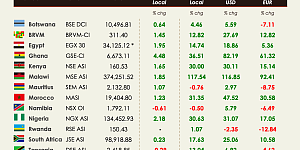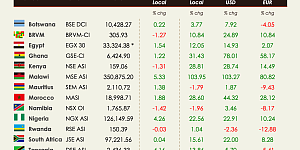Still mixed trends this week on African markets with the highlight being signals of a recovery banking sector in Zambia which drove strong performance of the local index.
In Kenya, most of the votes have been counted and it confirms President Kenyatta re-election. Uhuru Kenyatta has won over 96% of the votes counted so far from Thursday’s re-run election. The NSE rose 3.19%.
Bank of Tanzania (BoT) expects inflation to remain within the national medium-term target of 5% to be supported by lower food prices due to favourable weather conditions. According to BoT’s Governor, despite a bit of pressure from crop prices which is a regional phenomenon, inflation should stay on course. He flagged liquidity squeeze happening in the country as well as in Kenya, Uganda and Rwanda due to a decline in foreign currency inflows and debt. The DSE lost 2.22%.
South African Finance Minister Gigaba made his first Medium Term Budget Policy Statement (MTBPS) in parliament this week. The MTBPS has historically been a valuable scorecard for progress made on the February budget providing detail on government’s spending priorities, fiscal objectives over the medium term and take on the South African economic context. Gigaba stated that his priority is to achieve inclusive growth and to transform South Africa’s economy. According to Gigaba, unemployment at 27.7% is at its highest level since 2003, and is mostly felt by youth while the wealth remains highly concentrated. 2017 Economic growth was revised downwards from 1.3% to 0.7% and is expected to reach 1.9% by 2020. Gigaba increased the fiscal deficit forecast for this year to 4.3% of GDP from 3.1% in April because of shortfalls in revenues and costly bailouts to struggling state-owned companies. The jury is still out on whether given a highly bearish MTBPS report, the risks of credit ratings downgrades at the end of the year have risen materially. The JSE gained 1.32%.
Namdeb, a joint venture between the Namibian government and Anglo American’s diamond unit De Beers, plans to close four mines by 2022. Diamonds generate 20% of Namibia’s foreign export earnings. However, many of the major onshore deposits have now been depleted. In June, De Beers launched the world’s largest diamond exploration ship to operate off the coast of Namibia. The NSX lost 1.15%.
In Zambia, First National Bank of Zambia Q3 earnings soared to ZMW43.6 mn from ZMW6.05 mn in 1H2017 after credit impairments – on both the retail and corporate side – for Q2 almost wiped the bank’s earnings. So far, Q3 banking sector earnings indicate a recovery from the autopsy of liquidity stress experienced last year which forced most banks to book expensive liabilities which have fallen off the books. In Zambia, industry impairments for most locally registered banks are still high, banks have 50% of their books impaired. This has contributed to the 12.4% industry impairment levels in breach of the 10% threshold. However, FNB still remains a resilient bank in the Zambian market. The LuSE gained 3.34%.
In Uganda, Stanbic Bank has become the first bank to be granted a bancassurance license by the Insurance Regulatory Authority of Uganda. The USE gained 1.53%.










































